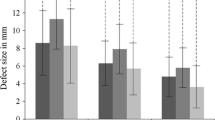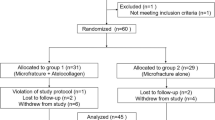Abstract
Purpose
Magnetic resonance imaging (MRI) findings of subchondral bone marrow edema (SBME) in osteochondral lesions of the talus (OLT) after arthroscopic microfracture are associated with poor clinical outcomes. However, the relationship between SBME volume change and clinical outcomes has not been analyzed. It was hypothesized that clinical outcomes correlated with SBME volume change and extent of cartilage regeneration in patients with OLT.
Methods
64 patients who underwent arthroscopic microfracture for OLT were followed up for more than 2 years. SBME volume change was measured by comparing preoperative and 2-year follow-up MRI. Clinical outcomes were assessed using the visual analogue scale (VAS) and the American orthopedic foot and ankle society ankle-hindfoot scale (AOFAS) at the 2-year and final follow-up. To compare clinical outcomes, patients were categorized into two groups: decreased SBME (DSBME) group (cases without SBME on either MRI or with a decreased SBME volume between the MRIs) and increased SBME (ISBME) group (cases with new SBME on postoperative MRI or with an increased SBME volume between the MRIs). Additionally, the effects of age, sex, body mass index, symptom duration, OLT size, OLT location, containment/uncontainment, preoperative subchondral cysts, pre- and postoperative SBME volumes, and MRI observation of cartilage repair tissue score on clinical outcomes were analyzed.
Results
The DSBME group included 45 patients, whereas the ISBME group included 19. The mean age was 40.1 ± 17.2 years, and mean follow-up period was 35.7 ± 18.3 months. Preoperative SBME volume was significantly higher in the DSBME group, while the ISBME group had higher volumes at the final follow-up. In both groups, the VAS and AOFAS scores significantly improved at the final follow-up (p < 0.001, < 0.001). The VAS scores were significantly lower in the DSBME group at the 2-year and final follow-up (p = 0.004, 0.011), while the AOFAS scores were significantly higher (p = 0.019, 0.028). Other factors including cartilage regeneration did not affect clinical outcomes.
Conclusion
SBME volume change correlated with clinical outcomes after arthroscopic microfracture for OLT. Clinical outcomes were worse in patients with new postoperative SBME and increased postoperative SBME volume. In patients with an unsatisfactory clinical course that show decreased SBME via postoperative MRI, an extended follow-up in a conservative manner could be considered.
Level of evidence
Level III.

Similar content being viewed by others
References
Albano D, Martinelli N, Bianchi A, Giacalone A, Sconfienza LM (2017) Evaluation of reproducibility of the MOCART score in patients with osteochondral lesions of the talus repaired using the autologous matrix-induced chondrogenesis technique. Radiol Med 122(12):909–917
Alparslan L, Winalski CS, Boutin RD, Minas T (2001) Postoperative magnetic resonance imaging of articular cartilage repair. Semin Musculoskelet Radiol 5(4):345–363
Amendola A, Panarella L (2009) Osteochondral lesions: medial versus lateral, persistent pain, cartilage restoration options and indications. Foot Ankle Clin 14(2):215–227
Becher C, Driessen A, Hess T, Longo UG, Maffulli N, Thermann H (2010) Microfracture for chondral defects of the talus: maintenance of early results at midterm follow-up. Knee Surg Sports Traumatol Arthrosc 18(5):656–663
Bining HJ, Santos R, Andrews G, Forster BB (2009) Can T2 relaxation values and color maps be used to detect chondral damage utilizing subchondral bone marrow edema as a marker? Skelet Radiol 38(5):459–465
Chan KW, Ferkel RD, Kern B, Chan SS, Applegate GR (2018) Correlation of MRI appearance of autologous chondrocyte implantation in the ankle with clinical outcome. Cartilage 9(1):21–29
Choi WJ, Choi GW, Kim JS, Lee JW (2013) Prognostic significance of the containment and location of osteochondral lesions of the talus: independent adverse outcomes associated with uncontained lesions of the talar shoulder. Am J Sports Med 41(1):126–133
Choi WJ, Park KK, Kim BS, Lee JW (2009) Osteochondral lesion of the talus: is there a critical defect size for poor outcome? Am J Sports Med 37(10):1974–1980
Chuckpaiwong B, Berkson EM, Theodore GH (2008) Microfracture for osteochondral lesions of the ankle: outcome analysis and outcome predictors of 105 cases. Arthroscopy 24(1):106–112
Cuttica DJ, Shockley JA, Hyer CF, Berlet GC (2011) Correlation of MRI edema and clinical outcomes following microfracture of osteochondral lesions of the talus. Foot Ankle Spec 4(5):274–279
Deol PP, Cuttica DJ, Smith WB, Berlet GC (2013) Osteochondral lesions of the talus: size, age, and predictors of outcomes. Foot Ankle Clin 18(1):13–34
Dombrowski ME, Yasui Y, Murawski CD, Fortier LA, Giza E, Haleem AM et al (2018) Conservative management and biological treatment strategies: proceedings of the international consensus meeting on cartilage repair of the ankle. Foot Ankle Int 39(1_suppl):9S–15S
Ferkel RD, Zanotti RM, Komenda GA, Sgaglione NA, Cheng MS, Applegate GR et al (2008) Arthroscopic treatment of chronic osteochondral lesions of the talus: long-term results. Am J Sports Med 36(9):1750–1762
Hannon CP, Murawski CD, Fansa AM, Smyth NA, Do H, Kennedy JG (2013) Microfracture for osteochondral lesions of the talus: a systematic review of reporting of outcome data. Am J Sports Med 41(3):689–695
Ibrahim T, Beiri A, Azzabi M, Best AJ, Taylor GJ, Menon DK (2007) Reliability and validity of the subjective component of the American Orthopaedic Foot and Ankle Society clinical rating scales. J Foot Ankle Surg 46(2):65–74
Jung HG, Carag JA, Park JY, Kim TH, Moon SG (2011) Role of arthroscopic microfracture for cystic type osteochondral lesions of the talus with radiographic enhanced MRI support. Knee Surg Sports Traumatol Arthrosc 19(5):858–862
Koo TK, Li MY (2016) A guideline of selecting and reporting intraclass correlation coefficients for reliability research. J Chiropr Med 15(2):155–163
Kuni B, Schmitt H, Chloridis D, Ludwig K (2012) Clinical and MRI results after microfracture of osteochondral lesions of the talus. Arch Orthop Trauma Surg 132(12):1765–1771
Lee KB, Park HW, Cho HJ, Seon JK (2015) Comparison of arthroscopic microfracture for osteochondral lesions of the talus with and without subchondral cyst. Am J Sports Med 43(8):1951–1956
Lee KT, Choi YS, Lee YK, Cha SD, Koo HM (2011) Comparison of MRI and arthroscopy in modified MOCART scoring system after autologous chondrocyte implantation for osteochondral lesion of the talus. Orthopedics 34(8):e356–362
Marlovits S, Singer P, Zeller P, Mandl I, Haller J, Trattnig S (2006) Magnetic resonance observation of cartilage repair tissue (MOCART) for the evaluation of autologous chondrocyte transplantation: determination of interobserver variability and correlation to clinical outcome after 2 years. Eur J Radiol 57(1):16–23
Marlovits S, Striessnig G, Resinger CT, Aldrian SM, Vecsei V, Imhof H et al (2004) Definition of pertinent parameters for the evaluation of articular cartilage repair tissue with high-resolution magnetic resonance imaging. Eur J Radiol 52(3):310–319
Posadzy M, Desimpel J, Vanhoenacker F (2017) Staging of osteochondral lesions of the talus: MRI and cone beam CT. J Belg Soc Radiol 101(Suppl 2):1
Ramponi L, Yasui Y, Murawski CD, Ferkel RD, DiGiovanni CW, Kerkhoffs G et al (2017) Lesion size is a predictor of clinical outcomes after bone marrow stimulation for osteochondral lesions of the talus: a systematic review. Am J Sports Med 45(7):1698–1705
Recht M, White LM, Winalski CS, Miniaci A, Minas T, Parker RD (2003) MR imaging of cartilage repair procedures. Skelet Radiol 32(4):185–200
Schreiner MM, Raudner M, Marlovits S, Bohndorf K, Weber M, Zalaudek M et al (2019) The MOCART (magnetic resonance observation of cartilage repair tissue) 2.0 knee score and atlas. Cartilage. https://doi.org/10.1177/1947603519865308
Shimozono Y, Coale M, Yasui Y, O'Halloran A, Deyer TW, Kennedy JG (2018) Subchondral bone degradation after microfracture for osteochondral lesions of the talus: an MRI analysis. Am J Sports Med 46(3):642–648
Shimozono Y, Donders JCE, Yasui Y, Hurley ET, Deyer TW, Nguyen JT et al (2018) Effect of the containment type on clinical outcomes in osteochondral lesions of the talus treated with autologous osteochondral transplantation. Am J Sports Med 46(9):2096–2102
Shimozono Y, Hurley ET, Yasui Y, Deyer TW, Kennedy JG (2018) The presence and degree of bone marrow edema influence midterm clinical outcomes after microfracture for osteochondral lesions of the talus. Am J Sports Med 46(10):2503–2508
Tao H, Shang X, Lu R, Li H, Hua Y, Feng X et al (2014) Quantitative magnetic resonance imaging (MRI) evaluation of cartilage repair after microfracture (MF) treatment for adult unstable osteochondritis dissecans (OCD) in the ankle: correlations with clinical outcome. Eur Radiol 24(8):1758–1767
Toale J, Shimozono Y, Mulvin C, Dahmen J, Kerkhoffs G, Kennedy JG (2019) Midterm outcomes of bone marrow stimulation for primary osteochondral lesions of the talus: a systematic review. Orthop J Sports Med 7(10):2325967119879127
Weigelt L, Hartmann R, Pfirrmann C, Espinosa N, Wirth SH (2019) Autologous matrix-induced chondrogenesis for osteochondral lesions of the talus: a clinical and radiological 2- to 8-year follow-up study. Am J Sports Med 47(7):1679–1686
Welsch GH, Mamisch TC, Zak L, Blanke M, Olk A, Marlovits S et al (2010) Evaluation of cartilage repair tissue after matrix-associated autologous chondrocyte transplantation using a hyaluronic-based or a collagen-based scaffold with morphological MOCART scoring and biochemical T2 mapping: preliminary results. Am J Sports Med 38(5):934–942
Yasui Y, Ramponi L, Seow D, Hurley ET, Miyamoto W, Shimozono Y et al (2017) Systematic review of bone marrow stimulation for osteochondral lesion of talus - evaluation for level and quality of clinical studies. World J Orthop 8(12):956–963
Funding
No funding was received.
Author information
Authors and Affiliations
Corresponding author
Ethics declarations
Conflict of interest
The authors have no conflicts of interest to declare.
Ethical approval
This study was approved by the ethical committee of the institution.
Additional information
Publisher's Note
Springer Nature remains neutral with regard to jurisdictional claims in published maps and institutional affiliations.
Rights and permissions
About this article
Cite this article
Ahn, J., Choi, J.G. & Jeong, B.O. Clinical outcomes after arthroscopic microfracture for osteochondral lesions of the talus are better in patients with decreased postoperative subchondral bone marrow edema. Knee Surg Sports Traumatol Arthrosc 29, 1570–1576 (2021). https://doi.org/10.1007/s00167-020-06303-y
Received:
Accepted:
Published:
Issue Date:
DOI: https://doi.org/10.1007/s00167-020-06303-y




